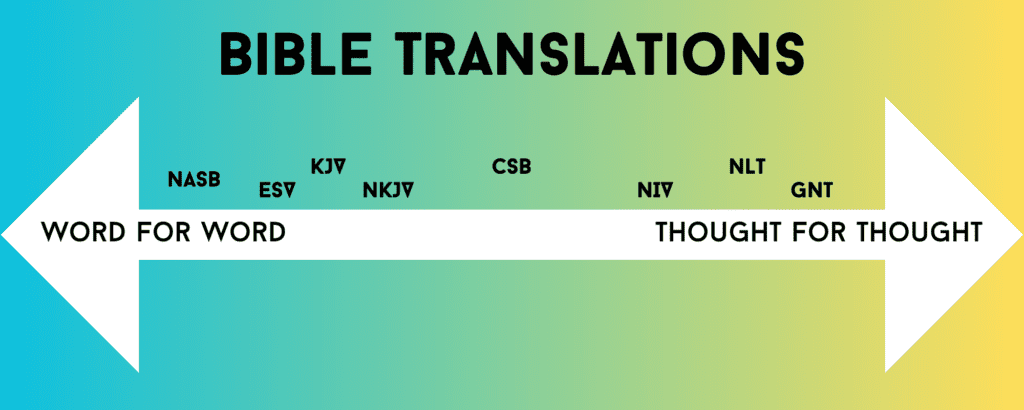No Bible No Breakfast, No Read No Feed. This is phrase that I have heard used by Evangelist , Ray Comfort, to communicate effective discipline when it comes to reading the Bible. Unfortunately, I rarely ever eat breakfast, so this doesn’t really apply to me. Plus “No Bible No Lunch” doesn’t have the same ring to it. The sentiment that he is getting across is that, daily bible reading is more important to a believer than food. Job 23:12 tells us to "esteem His Words more than our necessary food".
For new believers, getting into a Bible reading plan can very daunting. Especially when you consider that the Bible is not one book. It’s 66 books, split into 2 Testaments, Old and New. Even those 2 sections can be broken up with groups like the Torah (first 5 books), History, Poetry, Prophets, Gospels, Letters, Epistles, etc.
Not only does the Bible have many parts but there are many translations to choose from as well. There are A LOT of opinions when it comes to translations of the Bible. I’m not going to get too caught up in that in this post. I’ll share a few words about it and let you choose what works best for you.
Before we delve too deeply into which Bible is best for you, let me address a myth in the world of translations. Many skeptics like to claim that the Bible was translated over and over and over again, like a game of telephone, and things get “lost” in translation. This simply isn’t true. In fact we have thousands of full and partial manuscripts that scholars and translators can go back to when translating the Bible. It is true that there have been some translations that have been translated from the Greek to Latin, then to English, but most modern English translations do not do this. There are some organizations that will translate modern English bibles to other languages, but this is an effort to get the Bible into as many languages as possible, but they still have ancient manuscript evidence to support the translations if need be.
There is another pervasive myth that says Emperor Constantine assembled the Bible (Canon of Scripture) during the Council of Nicaea in 325 A.D. but this simply is not true. The Council of Nicaea was assembled to address a heretical view that denied the Deity of Jesus. The canon of scripture was well established organically long before this council. A later council addressed this, but at no point did they start throwing out books of the Bible, they simply affirmed the 27 New Testament books as canon.
Now let’s pick the best Bible for you.
When it comes to translation, there is a sliding scale of “Word for Word” and “Thought For Thought”. Some translations fall on one end of the spectrum and others fall on the other side, and some fall somewhere in between. Word for Word translations try to interpret the exact words from the original language. The benefit of this is that you can see almost exactly what the authors wrote. The downside is that it can come across a bit “clunky” in the reading. Thought for thought on the other had takes a little more liberty with what was actually said, and uses modern grammar rules and historical context to convey the thoughts/meaning behind what was written. An example of these would be the NASB (New American Standard Bible) in the Word for Word side, vs the NLT (New Living Translation) on Thought for Thought. On the far far end of the spectrum you find something called a Paraphrase like The Message or The Living Bible. These really aren’t translations at all, but they really attempt to get the words into as modern of a language as possible for ease of understanding. Paraphrases are a good tool for study but are not recommended for your daily reader.
The King James Version (KJV) is by far the most popular version of the Bible. Released in 1611, it had multiple revisions to the verbiage over the years, until about 1769. The 1769 version is the version most people are familiar with. It’s written with “Elizabethan”, which is not the common vernacular of today, but there are many Christian denominations that will only read the KJV. Some go so far as to ONLY read the 1611 version.
I would strongly advise that you steer clear of the KJVO (King James Version Only) debate. There are literally debates all over Youtube about this. For now I recommend that you find a translation that best suits you. If that is the KJV, that awesome! If it’s the ESV or NLT, that’s great too!
Take a look at this graphic for more info about the transaction spectrum. It is by no means and exhaustive list, but these are a few to look at.

I also recommend looking at more than one. Find a good Word for Word and a good Thought for Thought and compare the two. Having a physical Bible is great and I highly recommend it. Nothing compares to actually turning the pages of your Bible. However, free bible study apps are available to help you read many translations in one place. The You Version Bible App is one great resource.
A word of warning. There are some “translations” I would absolutely steer clear from. These translations either have a specific theological bent, or they have just plain bad scholarship and hermeneutics (the study of biblical literary texts). A few translations I would avoid include, The New World Translation, The Passion Translation, and The LDS Edition of the King James Version. Biblical Christians (Orthodox) also reject the writings of the Book of Mormon as heretical.
Once you find a solid translation of the Bible, it’s time to dig in to actually read it.
There are a lot of great devotionals and bible reading plans on the Bible App I mentioned before. But before you embark on reading the Bible cover to cover or chronologically in a year (things I highly recommend). Let’s start with some fundamental readings to give us a solid Biblical foundation.
My list is not authoritative by any means. Some other writers scholars and bloggers may disagree with me and that’s fine. As long as they are telling you to read your Bible, I am on board with them. Based on my own studies as well as working with new believers and kids in youth programs this happens to be my starting path.
The Gospel of John: there are 4 total Gospels. Matthew, Mark, and Luke are known as the Synoptic Gospels. Basically those 3 Gospels really try to get you a synopsis of Jesus’s life and his ministry. John is known as the Spiritual Gospel. It gets to the heart of who Jesus was/is as God in the flesh. This is an excellent starting point.
Ephesians: For me the Gospel of John is an obvious first choice. Most Bible teachers would agree. Number 2 is a tough one when you sift through all of the books to read. I picked Ephesians because this book (Letter from Paul) explains to the church in Ephesus how the work of Jesus on the Cross should effect our every day lives.
Colossians: Like Ephesians, this letter from Paul speaks a church that needs encouragement in walking in their new identity in Christ in a culture that makes it challenging to do so.
Matthew, Mark, Luke: Next you will want to go through the Synoptic Gospels and really absorb the life and teachings of Jesus. Take your time to appreciate the different perspective that each author gives to the account and how they compliment each other to give a fuller picture of the events.
Acts: If you finished with Luke’s Gospel and moved on to the Book of Acts (or Acts of the Apostles) then you are in for a treat as both books were written by Luke and carry the narrative forward. The Book of Acts is about the beginning of the Church, the infilling of the Holy Spirit, and the spreading of the Gospel. It also gives you a sneak peak into the lives of these men as they navigate the challenges of building the church. You will see how they rely on prayer to pull them through challenging situations.
Romans: The last book on my recommended path is the Book of Romans. This can be a very challenging book to read, but it is chock full of doctrine. It covers sin, grace, theology, struggling with faith etc.
Remember that as you are studying scripture that it’s a marathon and not a race. Really take your time as you get into these books. Keep in mind that this will also not be the last time you read any of these. You will continually go back to these books over and over as you study and rely on God’s word.
You can read a handful of chapters a day to get through it, but real study often means going though one or two in a day and meditating on it, praying about it. Looking for the historical context, reading commentaries and more.
If you are really hungry for the word (and I hope you are) consider adding in the book of Psalms with your daily reading. Read a Psalm a day, and make that a regular practice. This isn’t necessary but it’s a great way to keep His words in your heart.
Once you are ready to get into the Old Testament, take special note of prophecy. You will begin to see many parallels between the Old Testament prophecy and what Jesus did. You will see that the Bible has always led us to Christ.
Let us know how we can continue to support you on your faith Journey, and hopefully we will run into each other somewhere on the road.
